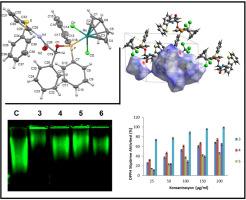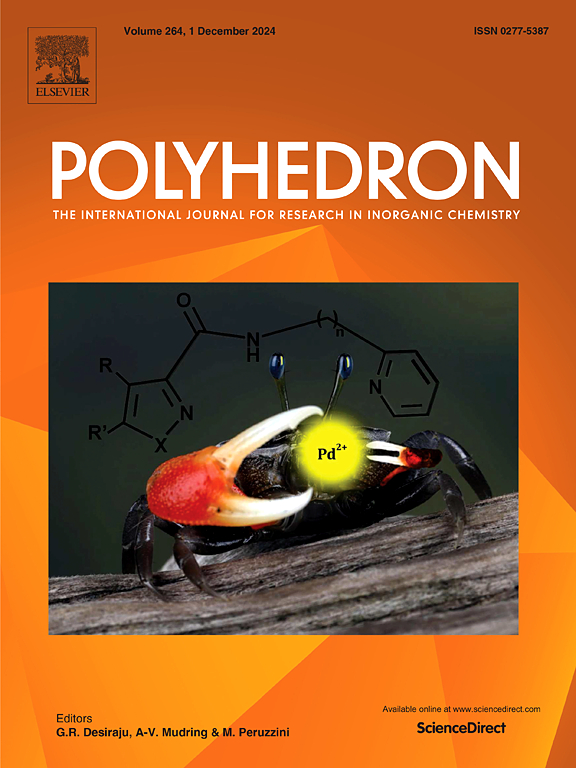微波法合成新一代氨基亚磷酸酯衍生物及其生物活性研究
IF 2.6
3区 化学
Q2 CHEMISTRY, INORGANIC & NUCLEAR
引用次数: 0
摘要
研究了一种亚磷酸盐的钌、铱、铑配合物的抗氧化、抗菌和DNA结合等生物活性。为此,首先在无溶剂环境下,利用微波辐射,由2-(苯基硫代)苯胺与dl -扁桃酸反应合成了一种新的酰胺。随后,这种酰胺被转化为它的亚磷酸盐对应物。然后,合成了亚磷酸盐的Ru(II), Ir(III)和Rh(I)配合物(3-6),并通过微量分析,Ir和NMR等多种技术进行了表征,对4进行了单晶x射线晶体学表征。最后,测试了[C20H16NOS{OPPh2-Ru(ηBergamini et al. (2004)6-p-花香烃)Cl2}](3)、[C20H16NOS{OPPh2-Ru(ηBergamini et al.(2004)6-苯)Cl2}](4)、[C20H16NOS{OPPh2-Ir(ηGaw et al. (2002)5- c5me5)Cl2}](5)和[C20H16NOS{OPPh2-Rh(cod)Cl}](6)配合物的抗氧化、抗菌和DNA结合活性。为了确定配合物的抗氧化活性,测定了DPPH(2,2-二苯基-1-苦味酰肼)自由基清除能力、金属螯合能力和还原能力。在200.0 mgL−1浓度下,配合物4具有最强的自由基清除能力(74.53±1.76%)和金属螯合活性(63.91±1.54%),而配合物3具有最强的还原能力。对四种病原菌进行抑菌活性测定。只有钌配合物3和4对两种革兰氏阳性菌有较弱的抑菌活性,其他配合物5和6没有抑菌活性。小牛胸腺DNA (CT-DNA)电泳结果显示,所有复合物都具有不同速率的DNA结合活性。本文章由计算机程序翻译,如有差异,请以英文原文为准。

Synthesis of new generation amido-Phosphinite derivative complexes by microwave method and investigation of their biological activities
Several biological activities such as antioxidant, antibacterial, and DNA binding of ruthenium, iridium, and rhodium complexes of a phosphinite were investigated. For this purpose, firstly, a new amide was synthesized from the reaction of 2-(phenylthio)aniline with DL-mandelic acid in a solvent-free environment using microwave irradiation. Subsequently, this amide was converted to its phosphinite counterpart. Then, Ru(II), Ir(III), and Rh(I) complexes (3–6) of the phosphinite were synthesized and characterized by several techniques such as microanalysis, IR, and NMR spectroscopy, and in the case of 4 by single crystal X-ray crystallography. Finally, antioxidant, antimicrobial, and DNA binding activities of [C20H16NOS{OPPh2-Ru(ηBergamini et al. (2004)6-p-cymene)Cl2}] (3), [C20H16NOS{OPPh2-Ru(ηBergamini et al. (2004)6-benzene)Cl2}] (4), [C20H16NOS{OPPh2-Ir(ηGaw et al. (2002)5-C5Me5)Cl2}] (5), and [C20H16NOS{OPPh2-Rh(cod)Cl}] (6) complexes were tested. To determine antioxidant activities of the complexes, DPPH (2,2-diphenyl-1-picryl hydrazyl) free radical scavenging, metal chelation, and reducing power activities were measured. At 200.0 mgL−1 concentration, complex 4 showed the highest radical scavenging (74.53 ± 1.76 %) and metal chelating activity (63.91 ± 1.54 %), while complex 3 exhibited the highest reducing power activity. Antibacterial activity of the compounds was determined with four pathogenic bacteria. Only ruthenium complexes 3 and 4 had weak activity against two Gram-positive bacteria, while the other complexes (5 and 6) did not show any antibacterial activity. Electrophoresis results using calf thymus DNA (CT-DNA) displayed that all complexes had DNA binding activity at different rates.
求助全文
通过发布文献求助,成功后即可免费获取论文全文。
去求助
来源期刊

Polyhedron
化学-晶体学
CiteScore
4.90
自引率
7.70%
发文量
515
审稿时长
2 months
期刊介绍:
Polyhedron publishes original, fundamental, experimental and theoretical work of the highest quality in all the major areas of inorganic chemistry. This includes synthetic chemistry, coordination chemistry, organometallic chemistry, bioinorganic chemistry, and solid-state and materials chemistry.
Papers should be significant pieces of work, and all new compounds must be appropriately characterized. The inclusion of single-crystal X-ray structural data is strongly encouraged, but papers reporting only the X-ray structure determination of a single compound will usually not be considered. Papers on solid-state or materials chemistry will be expected to have a significant molecular chemistry component (such as the synthesis and characterization of the molecular precursors and/or a systematic study of the use of different precursors or reaction conditions) or demonstrate a cutting-edge application (for example inorganic materials for energy applications). Papers dealing only with stability constants are not considered.
 求助内容:
求助内容: 应助结果提醒方式:
应助结果提醒方式:


